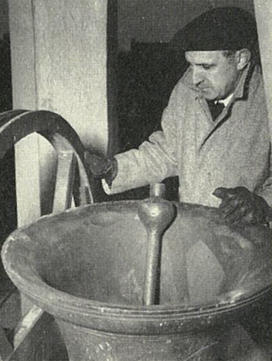Some listeners to the new bell claimed it did not seem to have the same “strength or volume of the old.” Professor Arthur L. Bigelow, the University bellmaster, conceded that the new bell did have several differences, but he assured these were for the best, predicting that the better-balanced replacement would last much longer than its predecessor.
Sixty-five years after this “new” bell came into commission, it will still be several decades before Bigelow’s predictions can be proved. The old one has found a home on the 100 level of the Frist Campus Center.
A New Bell for Nassau Hall
(From the March 4, 1955, issue of PAW)
In Princeton, where changes are more real than apparent, something was definitely different. Princetonians arriving for Alumni Day could sense it within a few hours. The bell in Old North was still.
It was a stillness that no stolen clapper would fix. The Nassau Hall Bell, which is authoritatively believed to have rung more often than any bell in the world, tolled its last toll at 11:30 on Friday morning, February 18, 1955. Summoning students to class, as it had for four generations, the bell spoke not in its own distinctive tone but with a plaintive croak.
The bell in Nassau Hall was 98 years old and had been living on borrowed time for more than a decade. According to Arthur L. Bigelow, bellmaster of the University, it has now developed a crack, though so small it can hardly be seen. Nonetheless, the bell has marked its last hour, signalled its last class, celebrated its last athletic victory. As the Prince put it in a headline, paraphrasing Donne by way of Hemingway, “It Tolled for Thee.”

With some muttering, it was noted that the new bell did not seem to have the strength or volume of the old, but Professor Bigelow gave assurances that this was not so. The difference was in the clapper, which is counter-balanced above the axle. Whereas the old bell was literally beaten to death by its clapper, the better-balanced bell of today will last much longer, preserving its beautiful tone. Moreover, says Mr. Bigelow, the bell’s tone will gain in strength as the clapper becomes worn. However, if still greater volume is required, the clapper can be made to give a harder blow. Meanwhile, the hammer which strikes the hours is the same, and hence the hours are sounded as loud or louder than before.
The old bell, worn as much as one-third through in some places in spite of frequent rotation, was cast in 1857 by Meneely’s Foundry, West Troy, N.Y., to replace the bell destroyed in the Nassau Hall fire of 1855. It was hung in the tower the following year, 97 years ago. Now that it has served its time, it is wandering in a sort of administrative purgatory awaiting final disposition for its life hereafter.











No responses yet